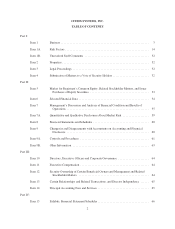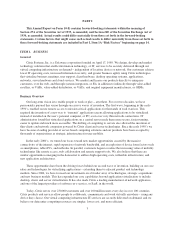Citrix 2009 Annual Report Download - page 20
Download and view the complete annual report
Please find page 20 of the 2009 Citrix annual report below. You can navigate through the pages in the report by either clicking on the pages listed below, or by using the keyword search tool below to find specific information within the annual report.majority of our manufacturing activity. These third-party contract manufacturers also provide final test,
warehousing and shipping services. This subcontracting activity extends from prototypes to full production and
includes activities such as material procurement, final assembly, test, control, shipment to our customers and
repairs. Together with our contract manufacturers, we design, specify and monitor the tests that are required to
meet internal and external quality standards. Our contract manufacturers manufacture our products based on
forecasted demand for our products. Each of the contract manufacturers procures components necessary to
assemble the products in our forecast and test the products according to our specifications. Products are then
shipped to our channel distributors, VARs or end-users. If the products go unsold for specified periods of time,
we may incur carrying charges or obsolete material charges for products ordered to meet our forecast or customer
orders. In 2009, we did not experience any material difficulties or significant delays in the manufacture and
assembly of our products.
We control all purchasing, inventory, scheduling, order processing and accounting functions related to our
operations. For our software products, production, warehousing and shipping are performed internally in the
United States and by independent contractors on a purchase order basis in Ireland, depending upon the
customer’s geographic market. Master software CD-ROMs, development of user manuals, packaging designs,
initial product quality control and testing are primarily performed at our facilities. In some cases, independent
contractors also duplicate CD-ROMs, print documentation and package and assemble products to our
specifications.
We do not believe that backlog, as of any particular date, is a reliable indicator of future performance.
While it is generally our practice to promptly ship product upon receipt of properly finalized purchase orders,
we sometimes have orders that have not shipped upon receipt of a purchase order. Although the amount of such
product license orders may vary, the amount, if any, of such orders at the end of a particular period is not
material to our business.
We believe that our fourth quarter revenues and expenses are affected by a number of seasonal factors,
including the lapse of many corporations’ fiscal year budgets and an increase in amounts paid pursuant to our
sales compensation plans due to compensation plan accelerators that are often triggered in the fourth quarter.
We believe that these seasonal factors are common within our industry. Such factors historically have resulted
in first quarter revenues in any year being lower than the immediately preceding fourth quarter. We expect this
trend to continue through the first quarter of 2010. In addition, our European operations generally generate lower
revenues in the summer months because of the generally reduced economic activity in Europe during the
summer. This seasonal factor also typically results in higher fourth quarter revenues.
Competition
We sell our products in intensely competitive markets. Some of our competitors and potential competitors
have significantly greater financial, technical, sales and marketing and other resources than we do. As the
markets for our products and services continue to develop, additional companies, including those with significant
market presence in the computer appliances and software and networking industries, could enter the markets in
which we compete and further intensify competition. In addition, we believe price competition could become a
more significant competitive factor in the future. As a result, we may not be able to maintain our historic prices
and margins, which could adversely affect our business, results of operations and financial condition. See
“—Technology Relationships” and Part I—Item 1A entitled “Risk Factors.”
Desktop Solutions
We have established a very large installed customer base in the application virtualization market due to our
early success applying this solution to remote access challenges. Today, this technology is part of an evolution
to a new way of managing desktops which is establishing a larger, encompassing market defined as desktop
virtualization. Our primary competition in this market is the existing IT desktop management practice of
12
























